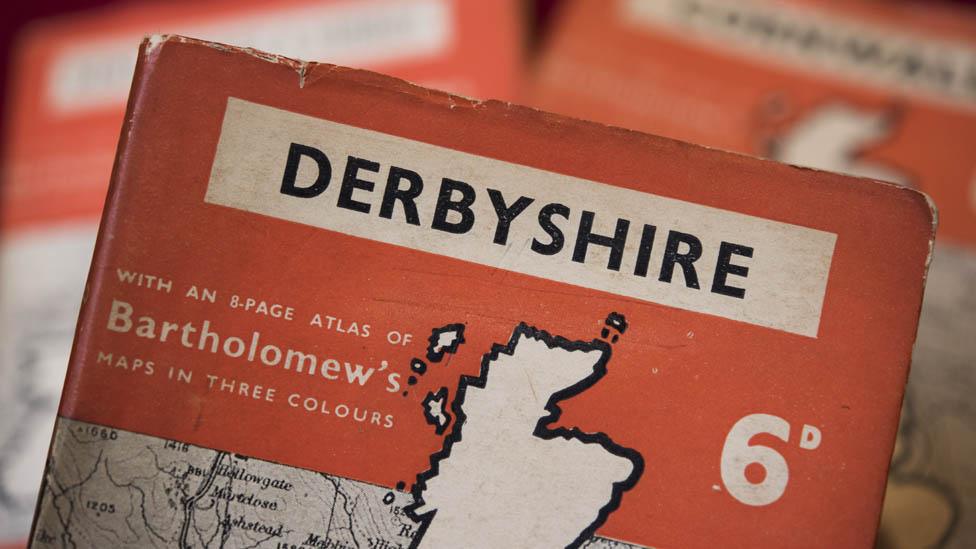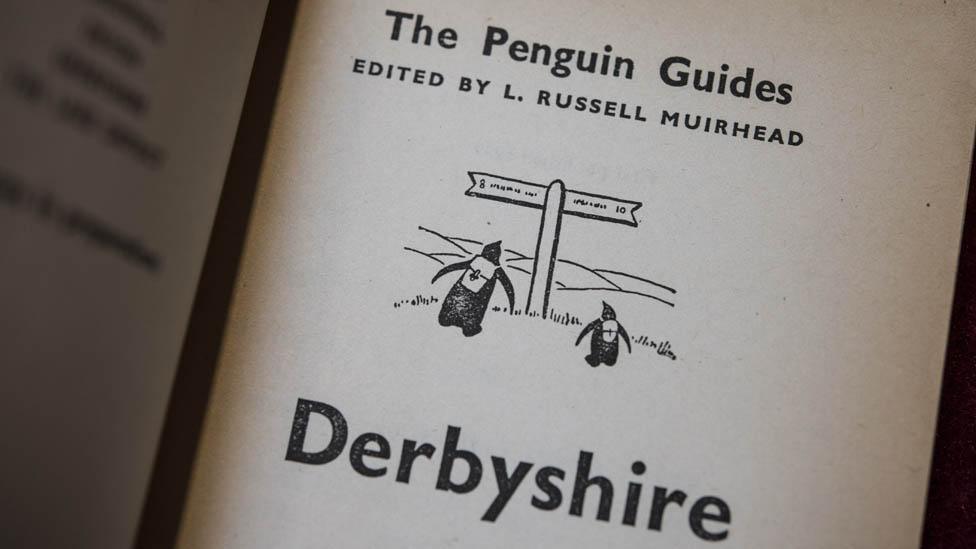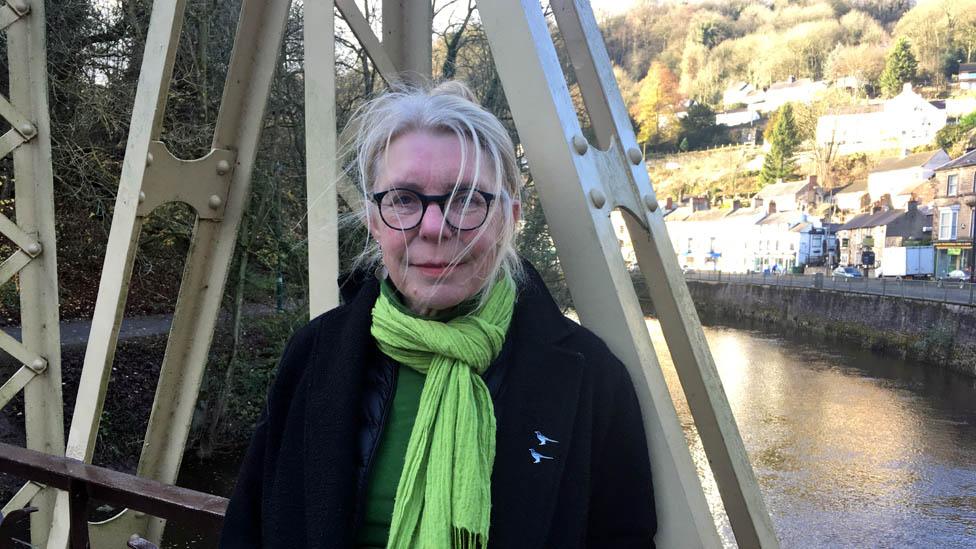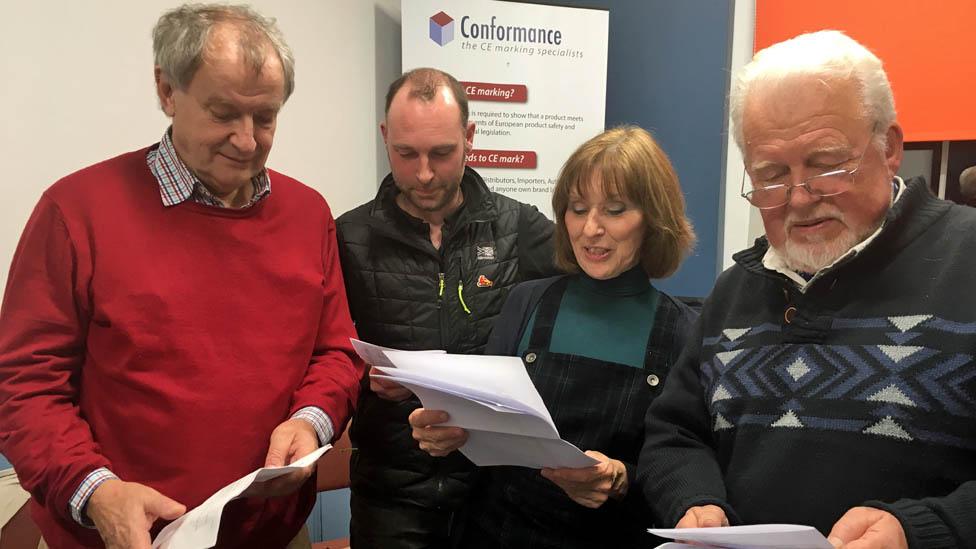The forgotten guide that took me to another time
- Published

In 1939, the newly established Penguin Books published six guides to various English counties, complete with touring maps, aimed at the middle-class motorist. Emma Jane Kirby has been driving around the UK with those first-edition guides in her hand to see how Britain has changed since the start of World War Two. Next stop: Derbyshire.
"The Peaklander," warns F C Mutton, the author of my 1939 Penguin County guide, "is somewhat taciturn."
Taking a breather half-way up the steep climb to the Heights of Abraham (cursing the fact that the cable car is shut for the winter months), I watch the low sun spark and glint off the roof tops of Matlock Bath below and understand immediately why the poet Byron was so fascinated with this landscape's rugged, harsh beauty. And not only Byron - my guide, Mutton, suggests that High Tor might well be the "loveliest crag in the whole of England".

The 1939 Penguin County guides appealed to holidaymakers who were keen to tick off as many "must-sees" as they could while zooming through the county in their cars. But the pace of the Derbyshire guide is rather slower than some of the others, as James Mackay from the Penguin Collectors Society notes.
"The Derbyshire volume is different because it was written by a local man," he explains. "And he was a rambler who worked for the railways and the emphasis is on that 1930s culture of going out into the countryside with a rucksack on your back, walking between railway stations and taking the train home again."
It's at Matlock Bath that I meet architectural historian Clare Hartwell, who has just finished revising the 1951 Pevsner guide to Derbyshire. I feel a little disloyal to Mutton as we chat together - although the Penguin county guides were reissued in 1947, it was the publication of more comprehensive, intellectual guides like Pevsner that ultimately led to the death of the Penguin guide.

Find out more
Read Emma Jane Kirby's account of following the 1939 Penguin guide to Kent
Listen her report on her visit to Derbyshire at 13:00 on 27 December on BBC Radio 4's The World at One
Or catch up later on the BBC iPlayer

"I'm not sure," says Hartwell, as we stroll up the main road, "what Mr Mutton would have made of all these fish and chip shops… but at least the colours are fairly muted. He would have found the funfair completely repellent, but again, it's largely hidden by tree cover - that says something about modern conservation policy."
In 1939, Mutton was hoping that "before long, some restrictions will be placed on the numerous advertising signs that clutter up the district", lamenting: "Although there is still much beauty left (in Matlock), there is much to jar the aesthetic taste… and there is no call for the automatic machine and pathetic little monkeys fastened up in cages."
Thankfully, there's no sign of the monkeys any more, but on this cold winter day, the slot and fruit machines are attracting plenty of customers.

I try to find the "warm swimming baths" that the guide promises me - Matlock was known as the home of hydropathy - but Hartwell explains that today they've been transformed into an aquarium.
In 1939, Derbyshire was renowned for its mineral and thermal baths and when I ask Hartwell if the curative spa town has seen its day, she suggests we drive to Buxton, one of the highest towns in England, where Mutton promises water that's rich in radioactivity and a chalybeate spring which is "of great value as a tonic" - and also (of particular interest to me in near-sighted middle-age) "to those with eye trouble".
I squint at the sign stuck on to the scaffolding and hoardings that hide a beautiful 1780s crescent and learn that after years of disuse, the Buxton baths will reopen in 2019, as a spa hotel complex.
Hartwell looks at me triumphantly.
"It all depends on what you mean by spa," she says. "People may not come for bathing and taking the water in the way they did - but people still take the Buxton water - they drink Buxton's bottled water. And even in 1939, people didn't just come to Buxton baths because they were ill - they came for the social life and when the spa hotel complex opens here in a couple of years, people will come to take a break but also to have fun."

Clare Hartwell
Still set on a massage, however, I head to the nearby Devonshire Royal Hospital, which is visited, according to Mutton, by "rheumatic patients of slender means from all over the kingdom". I push open the revolving door confidently - only to find myself in a cafeteria with throngs of young people clutching files and folders. The hospital is now part of the campus of Derby University.
If students have replaced the rheumatic patients, then tourists, thirsty for a dose of industrial heritage, have replaced the cotton and textile mill-workers.
"In 1939, people were trying to escape the factories into the countryside or to look at castles," historian Adrian Farmer explains as we walk towards Strutt's North Mill in Belper. "But today the mill is as different and alien to people as the castle once was - so now we are on the heritage and tourist trail."
Farmer shows me around the splendid museum that the mill now houses.
"Unesco recognised Belper as the birthplace of the factory and mass production," he says. "So our fame has spread worldwide and we even get people from China and Japan here, wanting to have their photo taken in front of the first factory - in 1939, people would have thought you must be deranged to do that."
I wonder if the people of 1939 would have thought that we were deranged if we could have told them that in 2017, no cotton would be spun in Britain any more, except perhaps in heritage museums.
"They wouldn't have believed you," smiles Farmer. "Until 1912, we were the world leader in cotton and in 1939 there was still a huge amount of cotton being spun here in the Derwent Valley. They would have expected that to continue forever."

Our Penguin guide was published in March 1939. Six months later, Britain was at war and the unsuspecting Belper factory workers would abruptly stop making hosiery and would instead start making camouflage netting for Army tanks.
I'm heading now into the "unspoiled, pastoral scenery" of central Derbyshire where Mutton tells me I'll find extensive dairy farming and can watch the huge churns of milk being sent by rail to London.
Ten miles west, Andrew Mycock, whose family has farmed here at Flagg for generations, laughs as he tips a hefty bag of feed in front of his calves' feeding fence.

Andrew Mycock
"Bulk artic tankers take everything off this farm," he says. "And you won't find many like me these days - the numbers of dairy farmers have halved here even in the last 10 years - it's a challenging industry."
Mycock has been up since 05:00, putting 350 cows through the milking parlour, feeding them and tending to his young stock. He'll finally call it a night around 22:00.
"It's a young man's game really, dairy farming," he explains. "And in 1939 it was really hard work. We have five times as many cows as my great grandfather did but they had no mechanisation - they had to shovel the muck then spread it on the fields while I sit in my warm tractor."
It's warm in the farmhouse sitting room where a grandfather clock ticks soothingly as we talk. Mycock blames the volatile milk prices for so many farmers throwing in the towel. He nods towards the grandfather clock.
"It's sad to see the cows go in many ways," he says, "but you can't ask time to stand still, can you?"

In the little village of Great Hucklow however, I have the feeling that time has done just that. Our 1939 guide, F C Mutton implores his readers to come here to catch one of the "outstanding performances" of L Du Garde Peach's Village Players, performed usually "when the moon is full". An unfortunate lack of full moonlight tonight sees me wasting several minutes struggling to get into the wrong chapel for rehearsals - the village still has no street lights.
When I finally find the right church hall, I'm welcomed by Peter Miles, Zak, John and Becky, who are having a spirited read through of one of Du Garde Peach's original comedy scripts, Summat Akin, set in a village "untouched by progress for 100 years".

The Great Hucklow Players - John, Zak, Becky and Peter Miles
I'm so taken with their excellent acting that it's a full minute before I realise I'm understanding only about one word in four. The play is written - and still performed - in a broad Derbyshire dialect. Du Garde Peach originally wrote the plays simply for the farmers and local people he knew and with the script written in the vernacular, they didn't have to act.
The original Village Players company folded in 1972, a couple of years before Du Garde Peach's death. But Peter Miles, who played in that final show, wanted to revive amateur dramatics in the area and the Great Hucklow Players now perform with the help of neighbouring villages. The thespian spirit has been passed down the genetic line - the parents of all the actors were also Village Players.
"As far as I know," grins Miles, showing me some photos of the first shows, "Peach never paid back the loan he took to buy the theatre building, but it was a loan well spent - it ran between 1938 and 1971. The building's still there but sadly it's no longer a theatre. It's now used as an outdoor pursuit centre. But we keep the spirit of the theatre alive by still putting on plays here in the village, particularly the Derbyshire comedies which were very popular in those days."
As I leave the chapel, Miles hands me a huge slice of lemon drizzle cake, made by his wife as a token of welcome. Driving back to my hotel in the car, I recall Mutton's warning in the Penguin guide that the Peaklander can be "somewhat taciturn", and I pull into a lay-by to study the reference more closely. It doesn't seem quite right, somehow, that the man who clearly loved every aspect of his county could have such a reservation about his own people.
With the help of a torch, I pick out his full phrase: "The Peaklander is somewhat taciturn, but never fails to respond to a friendly approach."

Join the conversation - find us on Facebook, external, Instagram, external, Snapchat , externaland Twitter, external.